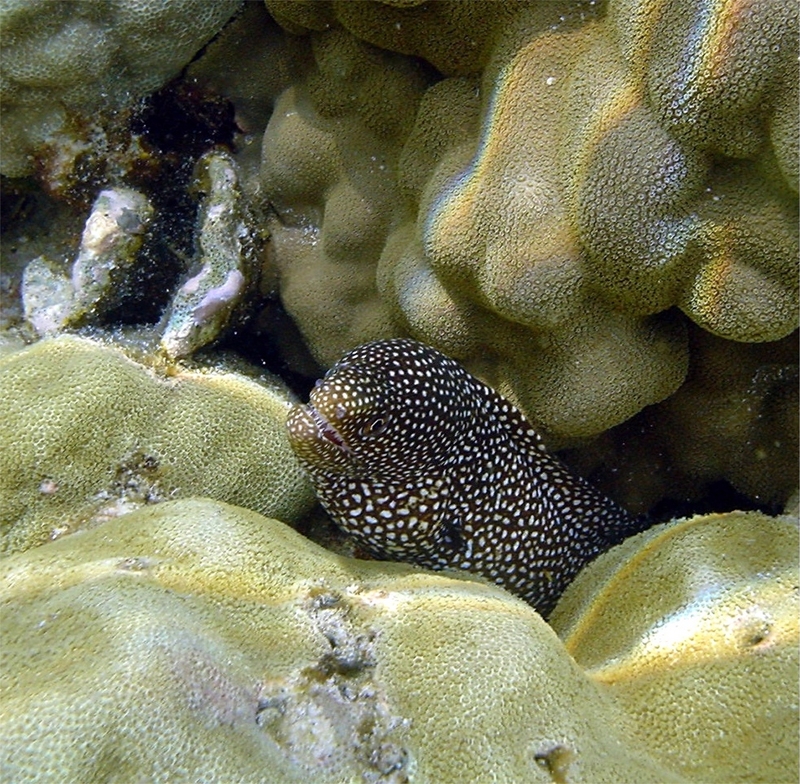|
| Query: small white | Result: 1272nd of 2237 | |
Moray Eel (Family: Muraenidae, Genus: Gymnothorax) - Wiki <!--곰치류-->
| Subject: | Moray Eel (Family: Muraenidae, Genus: Gymnothorax) - Wiki
| |

| Resolution: 1536x1506
File Size: 1632989 Bytes
Upload Date: 2007:09:07 11:00:31
|
Gymnothorax
From Wikipedia, the free encyclopedia
[Photo] Goldentail Moray (Gymnothorax miliaris).Moray eel in Kona, Hawaii. Date 2005. Author Mila Zinkova http://home.comcast.net/~milazinkova/Fogshadow.html
Gymnothorax is a genus of moray eels in the family Muraenidae.
Species
Dark moray, Gymnothorax afer Bloch, 1795
Whitemargin moray, Gymnothorax albimarginatus (Temminck & Schlegel, 1846)
Gymnothorax angusticauda (Weber & de Beaufort, 1916)
Gymnothorax angusticeps (Hildebrand & Barton, 1949)
Gymnothorax annasona (Whitley, 1937)
Gymnothorax annulatus Smith & B??hlke, 1997
Atoll moray, Gymnothorax atolli (Pietschmann, 1935)
South Pacific moray, Gymnothorax australicola Lavenberg, 1992
Southern moray, Gymnothorax austrinus B??hlke & McCosker, 2001
Gymnothorax bacalladoi B??hlke & Brito, 1987
Gymnothorax bathyphilus Randall & McCosker, 1975
Y-patterned moray, Gymnothorax berndti Snyder, 1904
Blackcheek moray, Gymnothorax breedeni McCosker & Randall, 1977
Vagrant moray, Gymnothorax buroensis (Bleeker, 1857)
Chestnut moray, Gymnothorax castaneus (Jordan & Gilbert, 1883)
Gymnothorax castlei B??hlke & Randall, 1999
Head-spot moray, Gymnothorax cephalospilus B??hlke & McCosker, 2001
Lipspot moray, Gymnothorax chilospilus Bleeker, 1865
Gymnothorax chlamydatus Snyder, 1908
Saddled moray, Gymnothorax conspersus Poey, 1867
Sieve-patterned moray, Gymnothorax cribroris Whitley, 1932
Gymnothorax dorsalis Seale, 1917
Speckled moray, Gymnothorax dovii (G??nther, 1870)
Elegant moray, Gymnothorax elegans Bliss, 1883
Enigmatic moray, Gymnothorax enigmaticus McCosker & Randall, 1982
Spotted-tail moray, Gymnothorax equatorialis (Hildebrand, 1946)
Abbott's moray eel, Gymnothorax eurostus (Abbott, 1860)
Gymnothorax eurygnathos B??hlke, 2001
Laced moray, Gymnothorax favagineus Bloch & Schneider, 1801
Fimbriated moray, Gymnothorax fimbriatus (Bennett, 1832)
Yellow-edged moray, Gymnothorax flavimarginatus (R??ppell, 1830)
Palenose moray, Gymnothorax flavoculus (B??hlke & Randall, 1996)
Gymnothorax formosus Bleeker, 1865
Green moray, Gymnothorax funebris Ranzani, 1840Brown spotted moray, Gymnothorax fuscomaculatus (Schultz, 1953)
Slendertail moray, Gymnothorax gracilicauda Jenkins, 1903
Geometric moray, Gymnothorax griseus (Lac??p??de, 1803)
Liver-colored moray eel, Gymnothorax hepaticus (R??ppell, 1830)
Gymnothorax herrei Beebe & Tee-Van, 1933
Lichen moray, Gymnothorax hubbsi B??hlke & B??hlke, 1977
Gymnothorax intesi (Fourmanoir & Rivaton, 1979)
Gymnothorax isingteena (Richardson, 1845)
Giant moray, Gymnothorax javanicus (Bleeker, 1859)
Whitespotted moray, Gymnothorax johnsoni (Smith, 1962)
Kidako moray, Gymnothorax kidako (Temminck & Schlegel, 1846)
Blacktail moray, Gymnothorax kolpos B??hlke & B??hlke, 1980
Gymnothorax kontodontos B??hlke, 2000
Gymnothorax longinquus (Whitley, 1948)
Sharktooth moray, Gymnothorax maderensis (Johnson, 1862)
Spotjaw moray, Gymnothorax mareei Poll, 1953
Blotch-necked moray, Gymnothorax margaritophorus Bleeker, 1865
Marshall Islands moray, Gymnothorax marshallensis (Schultz, 1953)
Gymnothorax mccoskeri Smith & B??hlke, 1997
Oman moray, Gymnothorax megaspilus B??hlke & Randall, 1995
Dwarf moray, Gymnothorax melatremus Schultz, 1953
Turkey moray, Gymnothorax meleagris (Shaw, 1795)
Gymnothorax microspila (G??nther, 1870)
Gymnothorax microstictus B??hlke, 2000
Goldentail moray, Gymnothorax miliaris (Kaup, 1856)
Gymnothorax minor (Temminck & Schlegel, 1846)
Moluccan moray, Gymnothorax moluccensis (Bleeker, 1865)
Drab moray, Gymnothorax monochrous (Bleeker, 1856)
One-spot moray, Gymnothorax monostigma (Regan, 1909)
California moray, Gymnothorax mordax (Ayres, 1859)
Spotted moray, Gymnothorax moringa (Cuvier, 1829)
Gymnothorax mucifer Snyder, 1904
Easter island moray, Gymnothorax nasuta de Buen, 1961
Gymnothorax neglectus Tanaka, 1911
Blackedge moray, Gymnothorax nigromarginatus (Girard, 1858)
Snowflake-patched moray, Gymnothorax niphostigmus Chen, Shao & Chen, 1996
Grey moray, Gymnothorax nubilus (Richardson, 1848)
Starry moray, Gymnothorax nudivomer (G??nther, 1867)
Gymnothorax nuttingi Snyder, 1904
Griffin's moray, Gymnothorax obesus (Whitley, 1932)
Caribbean ocellated moray, Gymnothorax ocellatus Agassiz, 1831
Panamic moray, Gymnothorax panamensis (Steindachner, 1876)
Gymnothorax parini Collette, Smith & B??hlke, 1991
Gymnothorax phalarus Bussing, 1998
Ghost moray, Gymnothorax phasmatodes (Smith, 1962)
Gymnothorax philippinus Jordan & Seale, 1907
Peppered moray, Gymnothorax pictus (Ahl, 1789)
Pike's moray, Gymnothorax pikei Bliss, 1883
Pinda moray, Gymnothorax pindae Smith, 1962
Polygon moray, Gymnothorax polygonius Poey, 1875
Gymnothorax polyspondylus B??hlke & Randall, 2000
Freshwater moray, Gymnothorax polyuranodon (Bleeker, 1853)
Lowfin moray, Gymnothorax porphyreus (Guichenot, 1848)
Yellow moray, Gymnothorax prasinus (Richardson, 1848)
Australian mottled moray, Gymnothorax prionodon Ogilby, 1895
Gymnothorax prismodon B??hlke & Randall, 2000
Gymnothorax prolatus Sasaki & Amaoka, 1991
Gymnothorax pseudoherrei B??hlke, 2000
Highfin moray, Gymnothorax pseudothyrsoideus (Bleeker, 1852)
Bars'n spots moray, Gymnothorax punctatofasciatus Bleeker, 1863
Red Sea whitespotted moray, Gymnothorax punctatus Bloch & Schneider, 1801
Gymnothorax randalli Smith & B??hlke, 1997
Reeve's moray, Gymnothorax reevesii (Richardson, 1845)
Gymnothorax reticularis Bloch, 1795
Richardson's moray, Gymnothorax richardsonii (Bleeker, 1852)
Gymnothorax robinsi B??hlke, 1997
Banded moray, Gymnothorax rueppellii (McClelland, 1844)
Gymnothorax sagenodeta (Richardson, 1848)
Gymnothorax sagmacephalus B??hlke, 1997
Ocellated moray, Gymnothorax saxicola Jordan & Davis, 1891
Gymnothorax serratidens (Hildebrand & Barton, 1949)
Gymnothorax sokotrensis Kotthaus, 1968
Steindachner's moray eel, Gymnothorax steindachneri Jordan & Evermann, 1903
Greyface moray, Gymnothorax thyrsoideus (Richardson, 1845)
Gymnothorax tile (Hamilton, 1822)
Undulated moray, Gymnothorax undulatus (Lac??p??de, 1803)
Brown moray, Gymnothorax unicolor (Delaroche, 1809)
Gymnothorax vagrans (Seale, 1917)
White-edged moray, Gymnothorax verrilli (Jordan & Gilbert, 1883)
Purplemouth moray, Gymnothorax vicinus (Castelnau, 1855)
Gymnothorax woodwardi McCulloch, 1912
Y-bar moray, Gymnothorax ypsilon Hatooka & Randall, 1992
Barredfin moray, Gymnothorax zonipectis Seale, 1906
http://en.wikipedia.org/wiki/Gymnothorax
| The text in this page is based on the copyrighted Wikipedia article shown in above URL. It is used under the GNU Free Documentation License. You may redistribute it, verbatim or modified, providing that you comply with the terms of the GFDL. |
|
Comments |
|---|
| | Samuel |
|
| GCjaaP Hello! I'm Samuel Smith, i'm from Switqerland i and find your site really brilliant! |
^o^
Animal Pictures Archive for smart phones
^o^
|
|
|